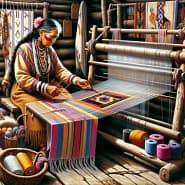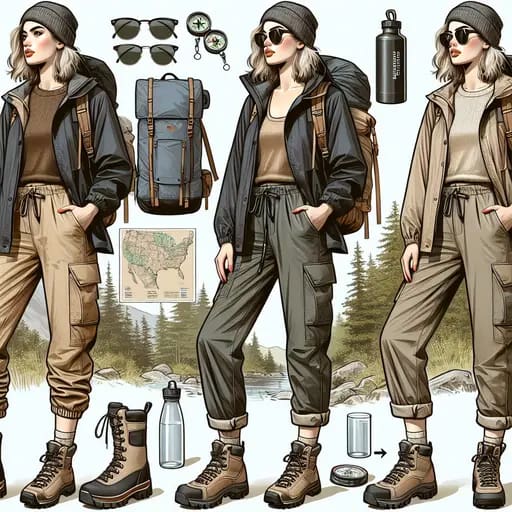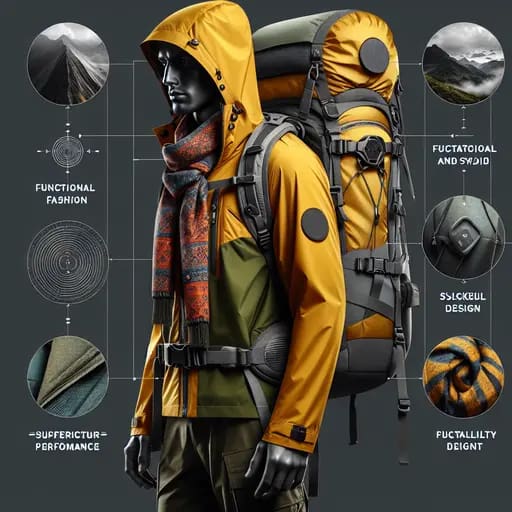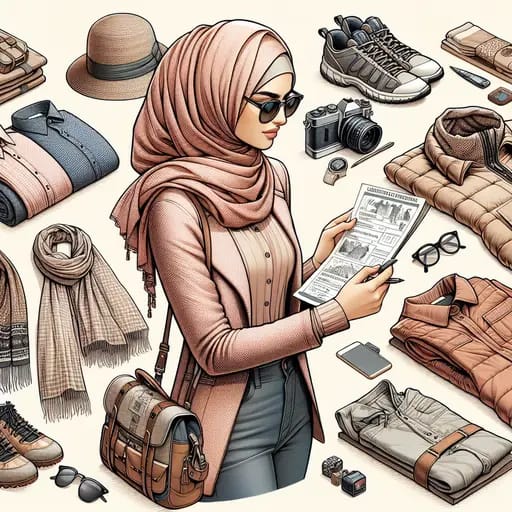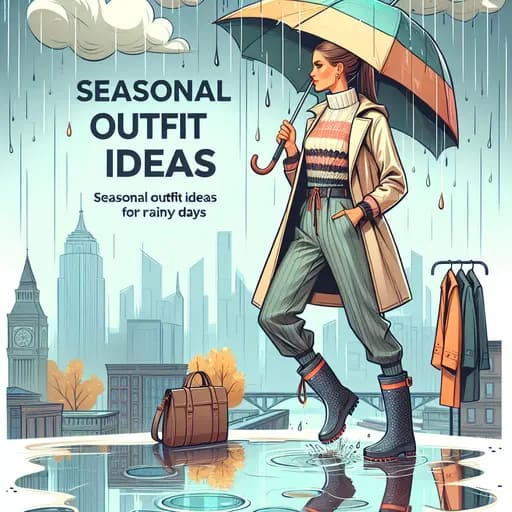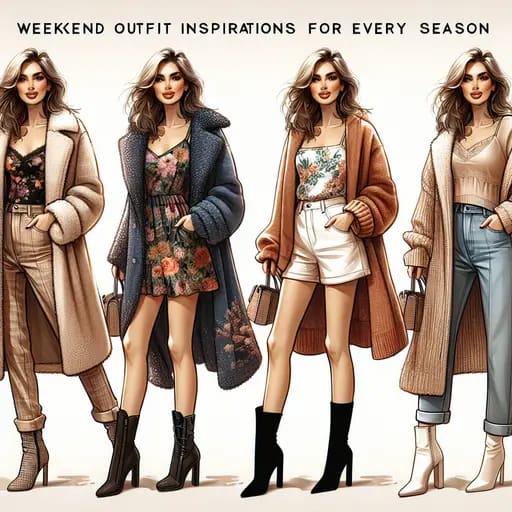Introduction: Why Dressing for Outdoor Weekends is Important
Embarking on an outdoor adventure is always a thrill, but knowing how to dress for these ventures is an art in itself. The importance of dressing aptly for outdoor weekends is often underemphasized. Not only does it serve an aesthetic purpose, but most importantly, it contributes to safety and comfort during your exploration. So, why exactly is mastering the art of “How to Dress for Outdoor Weekends” significant? Let’s delve into it.
Comfort and Functionality: Weekend explorations often involve unpredictable weather. Dressed appropriately, you remain comfortable and protected regardless of what nature decides to throw at you. Plus, dressing correctly boosts your spirits and keeps fatigue at bay.
- Choosing the right attire according to the weather conditions is crucial.
- You can layer your outfits to adapt to temperature fluctuations.
- Prioritizing comfort and functionality in footwear can greatly impact your adventure experience.
Style: Let’s face it. We all love to look good, and just because you’re heading outdoors doesn’t mean you have to sacrifice style. Mixing and matching your outfits can help you create stylish ensembles from limited pieces.
- Accessorizing not only serves practical needs but also helps you make a fashion statement in the wild.
- With clever mixing and matching, you can create multiple fashionable outfits with fewer pieces.
- Outdoor gear can be incorporated wholesomely into your outfit without compromising on style.
Safety: Dressing for outdoor weekends can also have a significant impact on your safety. Prioritizing the right attire and accessories can potentially save you from harmful elements in the wilderness.
So there you have it. Dressing for outdoor weekends entails balancing comfort, function, style, and safety. This style guide aims to furnish you with comprehensive information on achieving this equilibrium in order to make your outdoor weekends both thrilling and comfortable. Stay tuned for tips on choosing the right clothing for different weather conditions in the upcoming section.
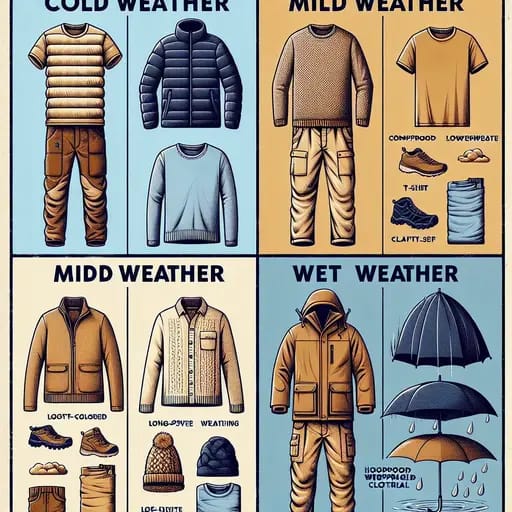
Choosing the Right Clothing for the Weather Conditions
Determining what clothes to wear for an outdoor weekend doesn’t only revolve around style, but much more importantly, it requires an anticipation of the weather conditions. Different climates demand different types of clothing – some aimed at keeping you warm, some for keeping you dry, and others for keeping you cool. Following are some key points to consider to be well-prepared for diverse weather conditions:
- Anticipate the temperature: Check the weather forecast for the location of your outdoor weekend. This will help you pack for the expected temperatures.
- Assess the rainfall prognosis: If the weather forecast predicts rain, ensure you have waterproof clothing items to stay dry and comfortable.
- Consider the sun exposure: Much exposure to the sun requires clothing that can protect you from the harmful UV rays. Hence, consider packing UV-protective clothing or a wide-brimmed hat.
- Wind is also crucial: If windy conditions are expected, wind-resistant clothes are a must-have. They reduce the wind chill and keep you warm.
To make your outdoor weekend more enjoyable and hassle-free, here is a brief guide to selecting the right clothes according to the different weather conditions.
- Cold Weather: Pack layers. Base layers that hold body heat, like thermal underwear, combined with insulating layers like wool sweaters, will keep you warm. Top it all off with a waterproof, wind-proof jacket.
- Mild Weather: Comfortable clothes that you can be layered are ideal. Include T-shirts, long-sleeve shirts, lightweight jackets, and maybe a sweater or two for the cooler evenings.
- Hot Weather: Choose light-colored, loose-fitting clothes that reflect sunlight. Cotton material can be a good choice as it allows your body to breathe and reduce sweat.
- Wet Weather: Waterproof jackets and pants, water-resistant footwear, and a quick-drip umbrella should be included in your packing list for rain.
Paying attention to the weather conditions and anticipating your clothing needs accordingly can take your outdoor weekend style from an average to an entirely new level. It also helps you stay comfortable and prepared for whatever the weekend may throw at you.
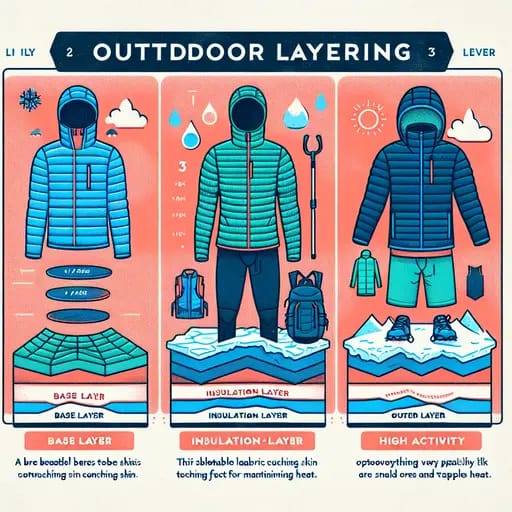
Layering: The Key to Versatility and Comfort
When it comes to dressing for outdoor weekends, the art of layering is paramount. This technique not only provides versatility, allowing you to adapt to changing weather conditions, but also ensures you remain comfortable throughout your adventures. So, how exactly can you master this technique? Here are some valuable insights:
- Start with a Base Layer: This layer is critical, as it’s the one in direct contact with your skin. It helps maintain your body temperature and wicks away sweat. Choose breathable, moisture-wicking fabrics like merino wool or synthetic materials.
- Insulation Layer: This is your mid-layer, crucial for trapping heat close to your body. Fleece and down jackets are top-rated choices for this layer, depending on the conditions outside.
- Outer Layer: Acting as a shield, this layer protects you from wind, rain, or snow. Pick waterproof, windproof, and breathable options for maximum comfort and protection.
Remember, the key to layering correctly is selecting the right materials. Stay away from cotton, as it absorbs moisture and takes longer to dry, which could leave you cold or even hypothermic in extreme cases. Lastly, remain flexible and adjust your layers depending on the activity level and current weather.
- Light Activity: If you’re planning for a leisurely hike or a picnic, you may only need your base and outer layers. It’s still wise to pack an insulating layer, just in case the wind picks up or the temperature drops.
- Moderate to High Activity: If you’re hitting the slopes or going for a run, you’ll need all three layers to manage sweat and maintain warmth. However, you may need to shed some layers as your body heats up. This is where the versatility of the layering technique shines through.
Layering is an essential part of your outdoor weekend style guide. Grasp this skill, and you’ll find dressing for any outdoor activity a breeze, staying stylish, comfortable, and prepared whatever the weather.
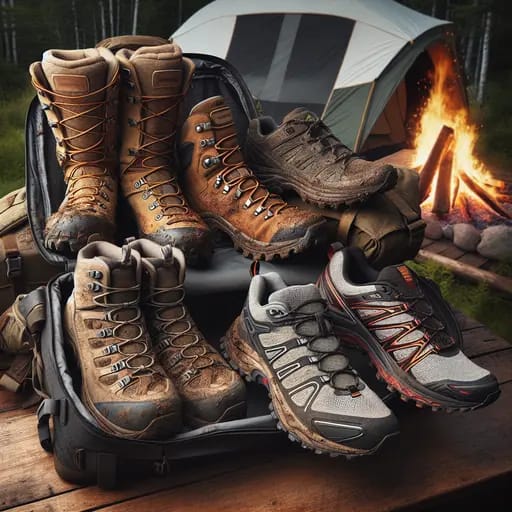
Footwear: Prioritizing Comfort and Functionality
While considering how to dress for outdoor weekends, footwear is an area that requires special attention. The shoes you choose can make a big difference not only for your look but also for your comfort and safety. What many often forget is that in an adventurous weekend on the outdoors, good footwear is more than just a stylish accessory – it’s a tool. Thus, it’s essential to balance the elements of comfort and functionality, close friends of any successful outdoor weekend enthusiast. First, we need to discuss the importance of prioritizing these two characteristics.
Why Comfort and Function Should Be Prioritized
Footwear that doesn’t offer the right amount of comfort can lead to blisters, pain, and even long-term foot damage, all of which can quickly diminish the fun of any outdoor weekend trip. On the other hand, shoes that don’t function well in the terrain or weather conditions you’ll be facing can cause slips, falls, or other injuries. When it comes to footwear, these are the reasons why you can’t afford to sacrifice either comfort or function.
Pointers to Choosing Comfortable and Functional Footwear
Here, we provide some pointers on how to make an informed decision about the footwear to pack for your forthcoming outdoor weekend. Consider these main factors:
- Weather conditions: If it’s likely to be wet, you’ll need waterproof boots. For hot, dry conditions, you’ll want breathable shoes.
- Terrain: For rocky or uneven terrain, hiking boots provide the best support. If the terrain is flat or even, running shoes or sneakers might be sufficient.
- Activity levels: If you’ll be hiking, walking, running or participating in high-impact activities, you need athletic shoes with good support.
- Size: Make sure your shoes are the right size. They should be snug but not tight, with some space for your toes.
Never underestimate the importance of footwear when planning how to dress for outdoor weekends. Remember, the right footwear not only completes your stylish, outdoor look but it also ensures you maintain a level of comfort that will allow you to enjoy your weekend activities in the great outdoors.
Footwear Recommendations for Your Outdoor Weekend
Knowing how to balance comfort and functionality in footwear can be quite complex. To make it easier, we’ve compiled a list of specific shoe recommendations for various outdoor activities:
- Hiking: The Merrell Moab 2 Mid Waterproof Hiking Boots offer excellent support, protection, and water resistance.
- Camping: The Salomon X Ultra 3 Low Aero Hiking Shoes are highly breathable and offer superior comfort for around-the-camp activities.
- Trail Running: The Brooks Cascadia 15 Trail-Running Shoes have solid traction and exceptional durability, perfect for rugged terrain.
Remember that functionality and comfort are key when it comes to selecting footwear for outdoor weekends. Follow these guidelines and recommendations, and you should be all set for a fun and comfortable adventure in the great outdoors!

Accessorizing for Style and Practicality
Accessories can make or break an outfit, and when it comes to outdoor weekends, they can be just as practical as they are stylish. Here’s how to accessorize for style and utility:
1. Hats
A hat is not only a great way to add a touch of style to your ensemble, but it also shields your face from the sun, rain or cold. Choose a hat suitable for the weather conditions like beanies for chilly environments or sun hats for warm and sunny ones.
2. Scarves
Scarves serve a dual purpose, adding a pop of color or pattern to your outfit and providing extra warmth. Opt for a lightweight scarf for moderate weathers and a thick, wooly one for colder conditions.
3. Sunglasses
Sunglasses aren’t just for looking cool. A good pair of polarized sunglasses protect your eyes from harmful UV rays and reduce glare making them a must-have for any outdoor weekend.
4. Jewelry
When it comes to jewelry, remember that less is more in the great outdoors. Opt for minimalistic pieces that won’t interfere with your activities. Avoid dangling earrings or loose bracelets that could get caught on something.
5. Backpacks and Bags
Your choice of bag can significantly affect your comfort and mobility. Go with a backpack for hands-free exploration, or a stylish crossbody bag for easier access to your essentials.
6. Belts
Besides holding your pants up, belts can give your outfit a more polished look. Consider a wide belt to cinch a bulky jacket at the waist creating a flattering silhouette.
Remember, when dressing for outdoor weekends, you can stay true to your personal style without sacrificing function. With careful selection, you can use accessories to enhance your outfit and navigate nature with ease.

Packing Essentials: Must-Have Items for Outdoor Weekends
Packing for an outdoor weekend can be a daunting task, particularly if the weather is unpredictable and you’re unsure of what to expect. However, there are a few essential items that should always be included in your luggage, irrespective of the season or location. These items not only ensure your comfort, but also play a key role in maintaining your style quotient.
Here are some must-have items to pack for your outdoor weekends:
I. Clothing
- Layers: As mentioned in the previous section, layers are the key to versatility and comfort. Always pack a variety of lightweight, medium, and heavy layers that can be added or removed based on the weather.
- Weather-appropriate clothing: Be prepared for sudden weather changes by packing rain gear, windbreakers, and warm clothing, even if you think you won’t need them.
- Extra socks: Socks can get wet or sweaty during outdoor activities. Pack a few extra pairs, prioritizing materials that dry quickly and defend against blisters.
II. Footwear
- Comfortable shoes: Whether you are hiking, trekking, or simply engaging in casual outdoor activities, comfortable footwear is crucial. Additionally, make sure your shoes are suited for the specific terrain you’ll encounter.
III. Accessories
- Protective gear: Depending on your activities, protective gear like hats, sunglasses, or gloves might be necessary. These items not only safeguard you from the elements, but also add to your style statement.
IV. Outdoor Gear
- Outdoor gear: Essential outdoor gear should be part of your pack. This includes items like a tent, sleeping bag, and flashlight, depending on the nature of your outdoor weekend.
As you pack for your outdoor weekend, it’s important to balance practicality with style. The right items will keep you comfortable and safe while also allowing you to express your personal style. So, keep this style guide at hand as you prepare for your next adventure and make your outdoor weekends memorable and fashion-forward.
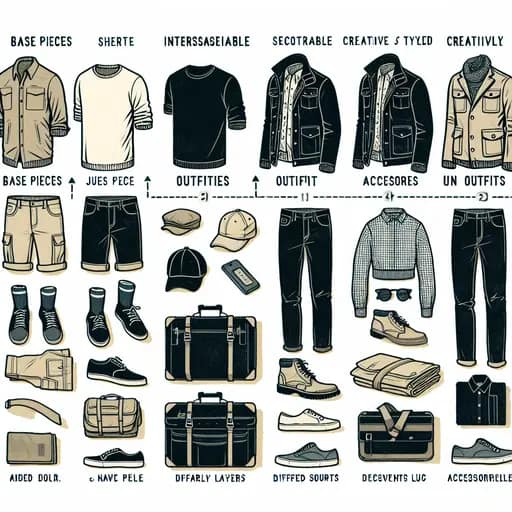
Mixing and Matching: Creating Multiple Outfits with Fewer Pieces
Every outdoor enthusiast knows that dressing for outdoor weekends is more than picking sweatshirts and jeans. It’s about fashionably expressing yourself while maintaining the practicality of utility. The latter becomes especially important when you’re tight on luggage space. Therefore, creative ways to mix and match your clothing become crucial.
Identify Your Base Pieces
Your base pieces are versatile items that you can wear multiple times and in several ways. They include jeans, shorts, skirts and tees that are easy to pair together or with other clothes. Here are some tips:
- Pick neutral colors like black, white, navy blue, and khaki for your base items. These are easier to mix and match.
- Vary the fabrics for different base pieces to effortlessly switch between looks.
- Select well-fitted items that balance comfort and style.
Create Interchangeable Outfits
Successful mixing and matching requires thinking of your clothes in terms of possible outfits instead of as standalone pieces. With smart matching, three shirts and three bottoms can lead to nine different outfits. Tips for successful matching include:
- Add layers, like jackets, over pieces for a quick style change.
- Use different footwear to switch from casual to formal.
- Accessorize with belts, hats, or statement pieces to change the overall aesthetic.
Repeating Outfits Creatively
Repeating outfits doesn’t necessarily mean being repetitive. You can repeat an outfit without anyone noticing by alternating your top and bottom items, plus adding varying accessories or changing footwear. You’d be surprised how much mileage you can get out of one outfit!
Remember, the ultimate goal is to look stylish, feel comfortable, and carry fewer items. So, when packing for your next outdoor weekend, play around more with mixing and matching. It’s the key to adding extra oomph to your style while remaining practical and weight-conscious.



